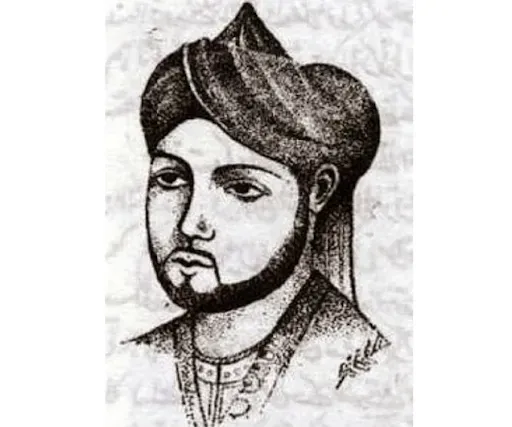Early Life and Education:
Amir Khusrau

Abu'l Hasan Yamīn ud-Dīn Khusrau better known as Amir Khusrau or Amir Khusro or Amir Khushrow, born in 1253 in Patiyali, Kasganj, India, was a polymath, poet, musician, and scholar who left an indelible mark on the cultural tapestry of medieval India. His father, Amir Saif-ud-Din Mahmud, hailed from Transoxiana, and his mother, a native Indian, infused in him a unique blend of Central Asian and Indian heritage.
From a young age, Khusrau exhibited a keen intellect and a profound interest in learning. His educational journey began under the tutelage of the illustrious poet and scholar Najmuddin Hasan. Khusrau's insatiable curiosity led him to study diverse fields, including philosophy, mathematics, and astronomy.
The Royal Patronage:
Khusrau's talents soon attracted the attention of the Delhi Sultanate's royal court, where he found patronage under the rulers of the Khalji and Tughlaq dynasties. His association with notable figures like Alauddin Khalji and later, the prolific poet and statesman Ghiyasuddin Tughlaq, provided him a platform to flourish.
Khusrau worked with Empires or Rulers:
Amir Khusrau, the versatile poet, and scholar served under several empires and rulers during his lifetime. Here is a list of empires and rulers he was associated with:
Delhi Sultanate (Under the Khalji Dynasty):
- Emperor: Alauddin Khalji
- Duration: Late 13th century (around 1296-1316)
Delhi Sultanate (Under the Tughlaq Dynasty):
- Emperor: Muhammad bin Tughlaq
- Duration: Early 14th century (around 1320-1325)
Delhi Sultanate (Under the Tughlaq Dynasty):
- Emperor: Feroz Shah Tughlaq
- Duration: Mid-14th century (around 1351-1388)
Delhi Sultanate (Under the Tughlaq Dynasty):
- Emperor: Ghiyasuddin Tughlaq II
- Duration: Late 14th century (around 1388)
Delhi Sultanate (Under the Sayyid Dynasty):
- Emperor: Muhammad bin Farid
- Duration: Late 14th century (around 1394-1406)
Delhi Sultanate (Under the Lodi Dynasty):
- Emperor: Sikandar Lodi
- Duration: Late 15th century (around 1489-1517)
Throughout his career, Amir Khusrau witnessed the changing landscapes of the Delhi Sultanate, serving under multiple rulers who belonged to different dynasties. His association with these empires allowed him to contribute significantly to the cultural and literary milieu of medieval India.
Literary Legacy:
Khusrau's literary contributions are a testament to his versatility. He excelled in various genres, including ghazals, masnavis, and rubais. His poetic oeuvre reflected the cultural syncretism of his time, seamlessly blending Persian and Hindavi (early Urdu) in a linguistic fusion known as "Hindvi."
In his divan, "Divan-e-Khusrau," and epic poems like "Matn-ul-Quloob" and "Nuh Sipihr," Khusrau masterfully explored themes of love, mysticism, and the socio-political milieu of his era. His ghazals, in particular, continue to resonate across centuries, capturing the essence of Sufi philosophy and the complexities of human emotions.
Musical Maestro:
Beyond his literary prowess, Khusrau's musical genius was equally noteworthy. He is credited with the invention of the musical genre "qawwali" and the introduction of the sitar and tabla into the Indian musical tradition. His compositions, especially the soul-stirring "qaul," exemplify the spiritual depth embedded in his work.
Legacy and Impact:
Amir Khusrau's legacy reverberates through the annals of Indian history. His literary and musical innovations laid the foundation for the development of Urdu and Indo-Persian poetry. The Chishti Sufi order, to which he was closely affiliated, venerates him as a spiritual luminary.
Notable writing of Amir Khusrau:
Amir Khusrau, a prolific poet, musician, and scholar, left behind a rich legacy of literary works. Here are some of his notable writings:
- Divan-e-Khusrau: This is a comprehensive collection of Khusrau's ghazals and other poetic forms. It showcases his mastery in both Persian and Hindavi, reflecting the cultural fusion of his time.
- Mathnawi-e-Nuh Sipihr (The Nine Skies): This epic poem explores themes of cosmic significance and divine love. It is written in Persian and reflects Khusrau's deep engagement with Sufi philosophy.
- Khamsa-e-Khusrau (The Quintet): Comprising five masnavis, this work includes "Matn-ul-Ans," "Hasht-Bihisht," "Laila-Majnun," "Ishqia," and "Tughluq-Nama." Each masnavi explores different facets of love, mysticism, and historical narratives.
- Qiran-us-Sa'dain (Meeting of Two Auspicious Stars): A prose work, Qiran-us-Sa'dain is a historical romance that narrates the love story of a prince and princess, symbolizing the union of India and Iran.
- Tughluq-Nama: This masnavi is a historical narrative that provides an account of the reign of Sultan Muhammad bin Tughlaq. Khusrau's witty and satirical style is evident in his depiction of the sultan's rule.
- Ghurrat-ul-Kamal (The Prime of Perfection): A biographical work, this book is a tribute to various saints and Sufi masters, reflecting Khusrau's deep spiritual inclinations.
- Nihayat-ul-Kamaal (The Zenith of Perfection): This work explores the life and teachings of Hazrat Nizamuddin Auliya, Khusrau's spiritual mentor. It is a testament to Khusrau's admiration for Sufi saints.
- Rasa'il-e-Khusrau (The Letters of Khusrau): A collection of Khusrau's letters, offering insights into his thoughts, beliefs, and interactions with contemporaries.
- Tuhfat-us-Sighr (The Gift of Childhood): An autobiographical work, Tuhfat-us-Sighr provides glimpses into Khusrau's early life, education, and the socio-cultural milieu of his time.
- Qaul-e-Farsi (Persian Sayings): This collection includes Khusrau's Persian verses and sayings, showcasing his command over the Persian language.